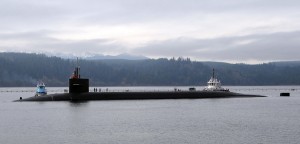
Women will be moving onto Ohio-class submarines later this year, but some accommodations, including berthing and privacy modifications need to be made first. Source: U.S. Navy
WASHINGTON — When Lt. Cmdr. Jean Sullivan joined the Navy 11 years ago, she never thought female officers would serve on submarines during her career. But now, she’s helping make it happen by the end of this year.
Sullivan and other officials on the committee preparing the service for female submariners said Tuesday that the transition is proceeding as planned.
Training for first group of 18 female submariners continues apace, with the officers scheduled to begin arriving at their submarines in November. They are scheduled to report to ballistic subs Wyoming and Maine and guided-missile subs Georgia and Ohio.
“These are highly, highly qualified women,” Sullivan said during Tuesday’s meeting of the Defense Advisory Committee on Women in the Services. “The majority of these women who wanted to be a part of the program were mechanical engineers and electrical engineers, some with two engineering degrees.”
To complete the shift, Congress must approve some spending to make minor modifications to the subs to accommodate women. Sullivan said no one in Congress pushed back when talk of the spending was presented.
“In fact, it was just crickets,” she said, “which I think shows sort of a change in time.
“It was quiet, just sort of like, ‘Let us know what happens.’ ”
Sullivan said she was unsure exactly how much it would take to modify a submarine to accommodate women, but the cost was $2 million per ship to similarly alter a surface combatant.
Some of the reconfigurations needed include privacy modifications and additional heads, a process that could get more complicated if submarines are opened up to enlisted women. At the officer level, women can share private bathrooms with men, just flipping a sign to show who’s using it. More expensive changes would be needed if the move is made to put enlisted women on subs.
The Defense Advisory Committee on Women in the Services also discussed the need to address submarine personnel behavior and family relations. Some wives might be concerned with the close quarters of the men and women in submarines, committee members noted.
“I imagine these were the same concerns in 1994 when we started integrating aviation and surface combatants,” Sullivan said. “But maintaining that this is the way ahead is how we need to combat that.”
Rear Adm. Barry Bruner, who led the task force on integrating women onto submarines, held meetings in the evenings for submarine families, Sullivan said. He wanted them to have a place to air concerns and did not leave until every question was answered, she said.
Retired Army Lt. Gen. Claudia Kennedy, chairwoman of the advisory committee, said there is risk of women being isolated if males on the subs feel their presence constrains them.
“One of the issues around women being integrated is this thought that, “Oh, now because you’re here, we can’t do XYZ,’ ” Kennedy said. “And that creates a greater sense of isolation and exclusion for women.”
Sullivan said Navy leadership support will help the shift move smoothly.
“Adm. [Jon] Greenert, a submariner, came to the March Women’s Leadership Symposium and when he says to a room full of 1,300 women in uniform, ‘This is a great and exciting event,’ that sends a message to the submarine community,” Sullivan said.
